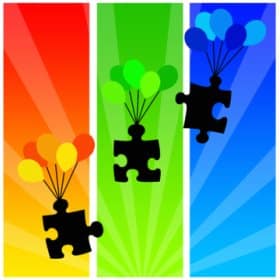How Your Brain Tricks You and How to Take Back Control by Marie Nameth
You and I were born with a brain that is set to “anxious” as the primary response to something that’s new or different, or people who have features that show they are different from our “clan.” The propensity for treating these unique situations with anxiety is called the Negativity Response, or Negativity Bias.
When you can see clearly what an anxious brain is, normal and natural, then you can respond appropriately to whatever situation in which you find yourself.
The first time I heard about the Negativity Response was from psychologist Rick Hanson, who wrote Hardwiring Happiness. He said our brain evolved to have a survival mechanism that’s attuned to potential threats, more than to anything positive, even treats!
You’ve probably experienced this:
Let’s say a coworker brings you a Danish—the kind you love—and you’re so happy. Then, a couple of hours later, another coworker gives negative feedback on something you’ve written.
At the end of the day, what do you remember? Probably not the Danish. You’ll remember the critique.
Why? Because our brains are wired to notice threats.
We needed that 100,000 years ago when we lived in caves. We had to respond to the possibility of danger just outside the cave.
And our brains haven’t evolved much since then. Seriously—we have basically the same brain we had 100,000 years ago.
Here are the defining features of the Negativity Response:
- Our brains give more weight to negative experiences than positive ones.
- We react more strongly to threats, criticism, or danger than to praise or reward.
- We remember negative events more vividly and for a longer time.
- We overestimate threats and underestimate opportunities.
- We overlearn from bad experiences.
You might be thinking, “Is this really true?”
Take a deep breath. Ask yourself: Am I willing to see this?
You see, those ancestors of ours who didn’t anticipate threats—like a tiger outside the cave—might not have lived long enough to pass on their genes.
So we’ve inherited this anxious wiring.
Psychologist Catherine Kam wrote about this too. In her article Your Brain Is Biased to Negativity: Here’s How to Become More Positive, she says that negative events feel more psychologically intense than positive ones. That’s true even when they’re equal in importance.
Ever been about to give a presentation and thought:
“Am I going to sound competent?”
“Will they believe me?”
“Am I good enough?”
This is the negativity response in action.
As Catherine Norris of Swarthmore College said, “Bad is stronger than good.”
Now, this Negativity Response does serve a purpose—it helps protect us from harm.
But in some of us, it can be heightened. That’s when we feel constant stress or anxiety, especially during big changes or when something familiar is no longer there.
Why am I repeating this? Because it’s so important to understand.
- Whether you’re writing a book, starting a business, or speaking in public, it’s like being at the entrance of the cave!
They once asked Stephen King how he starts writing. He said:
“I sit. I sweat. I sit. And when I start sweating blood—that’s when I start.”
The good news? Our brain is capable of neuroplasticity—it can change.
And here’s the key to your success in gently shaping your brain. Give the following statement time to sink into your awareness:
You are not your brain!
You have a brain. You also have two eyes, a nose, and a mouth—but you’re not those things.
You are the one who can shape your brain, who can train it to focus on what matters, and away from its tendency to become anxious..
Instead of following the Negativity Response, you can guide your brain toward creativity, generosity, and success.
Over the years, I’ve developed a definition of success that many have found to be helpful:
Success is doing what you said you would do consistently, with clarity, focus, ease, and grace.
- Clarity means becoming clear about what you truly want—not what you think you need to stay safe.
- Focus means choosing where you want your attention to go.
- Ease is about taking small, sweet steps—so you don’t overload your brain.
- Grace is the ability to recognize the blessings that are always around us.
Willa Cather, in her book Death Comes for the Archbishop, once wrote:
“Miracles… seem to me to rest not so much upon… healing power coming suddenly near us from afar but upon our perceptions being made finer, so that, for a moment, our eyes can see and our ears can hear what is there around us always.”
And the gateway to grace? Gratitude.
Try the following to gently turn your brain away from anxiety and toward gratitude:
Each morning, write in a journal:
- “Here’s one step I’ll take today with clarity, focus, ease, and grace.”
At night, write:
- “Here’s what I learned today.”
- “Here’s what I’m grateful for.”
Do that for 30 days. Watch what happens to your brain.
You can also ask:
- “What’s one thing I’ll do today to contribute to someone else?”
As Maya Angelou says in this short video clip, “Be a rainbow in someone else’s cloud.”
When we focus on contributing, we feel more purpose and less anxiety.
So yes, the Negativity Response is real—and it’s normal. But you have the ability to guide your brain toward what matters.
And here’s a little secret:
Sometimes, when I’m feeling anxious, I say to my brain, “It’s okay, honey. I’ve got you.”
Have compassion for this brain of yours—it’s just trying to protect you.
And when you treat it with kindness, you’ll develop a new kind of relationship with it—one where you can celebrate what it’s capable of, even with its natural tendency toward anxiety.
Until next time, be well.





